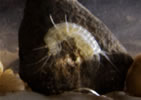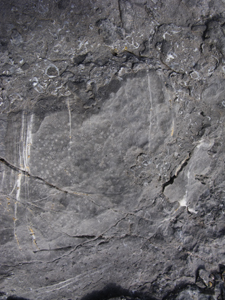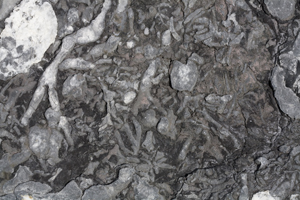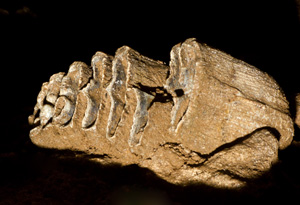Fossils in the limestone
Caves in Devon are formed in Middle Devonian limestone, deposited between 398-385 million years BP. These limestones are significantly older than the Carboniferous limestone of most other British caving areas. Thus the fossils to be found are quite different. Devonian limestone fossils can be seen in caves, but are not silicified so they are normally only seen in cross section in the cave wall.
The most important reef building animals in Middle Devonian seas were a group of calcareous sponges known as stromatoporoids. The main reef builders were tabular and domed forms such as Stromatopora. The delicate branched stromatoporoid Amphipora occurs in lagoon limestones.
|
Cylindrical root like Syringopora coral (small circles in centre of photograph) growing within a stromatoporoid sponge (the large grey rectangular lump). Surrounding the stromatoporoid fossil are veins of calcite, these were created when the limestone deformed but the more solid fossil did not, this created cracks around the fossil which have been filled with calcite.
Circular and semicircular Brachiopod fossils are at the top of the photograph. |
|
Two oval stromatoporoid fossils. |
Corals were abundant and diverse in Devonian seas. They belong to two major groups, the tabular and rugose corals, which are not closely related either to each other or to modern corals. Tabular corals were colonial; common species include Thamnopora (branched), Alveolites (tabular) and Favosites (domed). Rugose corals were often solitary, ranging from small zaphrentids a few centimetres long to large species such as Mesophyllum. Late in the Middle Devonian, colonial rugose corals such as Hexagonaria and Phillipsastraea became important.
|
Branching tabular coral Thamnopora |
 |
Transverse section of solitary Rugose coral |
The only group of molluscs which are at all likely to be encountered in Middle Devonian limestones are gastropods (snails). Snails are not very common but where they occur they can be abundant. When seen in cross section their spiral shape is distinctive.
|
Fossil Gastropod in Devonian limestone |
The most abundant shelly fossils in Middle Devonian seas are brachiopods (lamp shells). Brachiopods have two unequal shells, each symmetrical about the midline and they lived attached to the seafloor by a stalk - the pedicle. They were abundant and diverse on the Middle Devonian reefs but the species cannot be identified in cross section. Fossil brachiopods in section look like pale ellipses and semicircles.
Crinoids (sea lilies) were important in Middle Devonian reef environments. They consisted of a segmented stem with a crown of feathery arms on top. When the animal died it disintegrated into the individual segments (ossicles) or into short lengths of stem consisting of a few connected ossicles. Often, this debris drifted to accumulate as thick beds to form crinoidal limestones. The fossil ossicles appear in cross section as circles, ellipses and rectangles depending on the angle of the section. If a length of stem is found the joints between the ossicles can be seen.
Quaternary fossil mammals and archaeology
The Quaternary period spans the last 2 million years of earth history when the climate cooled, culminating in the ice ages of the Middle to Late Quaternary with ice sheets repeatedly covering much of Britain. Over the last 500,000 years Britain has experienced 5 full glacial cycles from warm (peak interglacial) to glacial and back to peak interglacial conditions. For most of each cycle, the climate was cool with steppe or tundra conditions, rather than the extremes of either peak interglacials (closed deciduous woodland) or full glacials (ice sheets with polar deserts to the south). We live in an interglacial period now - the Holocene.
At Kent’s Cavern and other sites, large carnivores including hyaenas and bears used to live in caves in the past, with hyaenas denning in the cave and bears using it for hibernation and winter breeding. Caves were also sometimes used by Palaeolithic man. At that time (~60,000-10,000 yrs BP), other creatures roaming about outside included horse, bison, reindeer, woolly rhino, and woolly mammoth: most of the bones of these species found in the cave were brought in by hyaenas. Evidence shows that Britain was fairly uninhabited during the coldest part of the ice age (26,000-13,000 yrs BP). During the last glaciation, Devon, in common with the rest of southern England, lay to the south of the ice sheets and conditions of arctic tundra existed here.
Cave entrances acted as sediment traps through the Quaternary period and preserved the bones of the animals living in the area. As mentioned above, Devon lay south of the glacial limit and was one of a few limestone areas to escape glaciation. Consequently it has a particularly good record of Quaternary fossil mammals and archaeology as no erosion by ice sheets has occurred. Bone deposits accumulated principally as a result of two mechanisms: shafts which acted as pitfall traps, and hyaena dens. Human use of caves dates mainly from the Late Quaternary period, with Middle Palaeolithic Neanderthal hunters using caves from about 60,000 years BP, replaced by early modern human Late Palaeolithic man around 35,000 years BP.
Devon includes many sites notable for their Quaternary and archaeological finds, including, amongst others, the caves near Chudleigh, Kent’s Cavern, Joint-Mitnor Cave and Brixham Cavern. Upon entering Bishop’s Chamber in Pridhamsleigh, cavers will notice the investigative trench dug in the floor by Amery during the 19th century.
Kents Cavern in Torquay contained an exceptionally long sequence of deposits. The earliest is the Breccia, a debris flow deposit in the inner part of the cave, which dates from around 400-500,000 years BP and contains the remains of the archaic cave bear Ursus deningeri (such as this jaw bone with tooth) along with crude Lower Palaeolithic handaxes and other flint implements. The bears appear to have been hibernating in the cave but the condition of the flints shows they were brought in by the debris flows and are derived from a pre-existing deposit on the surface. These flints may be evidence of some of the earliest human presence in Britain. A much younger deposit in the outer part of the cave, the Cave Earth dates from around 60,000 to 10,000 years BP. It is a hyaena den deposit containing a rich fauna with (in addition to abundant remains of the hyaenas themselves) bear, wolf, mammoth, woolly rhino, horse, reindeer, giant deer and bison. Some of the bones bear the teeth marks of hyena. Archaeology includes Middle, Early Upper and Late Upper Palaeolithic occupation horizons. The cave is a commercial show cave today and the bones of cave bears in the Breccia can still be seen in the cave. The cave earth was almost entirely removed by excavation but fossils and flints from the deposit are on display at the cave.
The other site is Joint Mitnor Cave at Buckfastleigh. This is a pitfall trap cave dating from the last interglacial period (about 120-130,000 years BP). Species found here include hippo, bison, fallow deer, wild boar, straight tusked elephant, lion and hyaena. Unusually, rather than removing the whole deposit, the excavators left a section in place, so that it is possible to visit the cave now and see the remains of last interglacial mammals, such as straight tusked elephant, still in the deposit. The cave is a show cave open for visits on several days each year.
|
Young elephant tooth, Joint Mitnor Cave |
|



.jpg)


.jpg)
